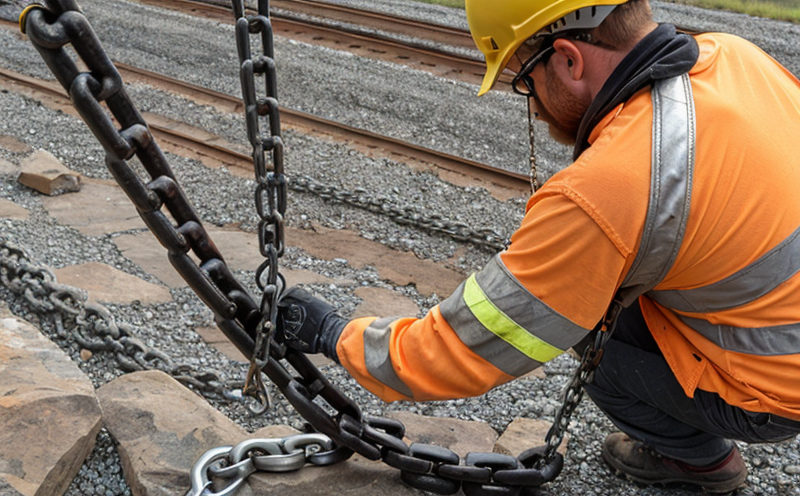Chain and sling inspection
The inspection of chain and slings is a critical aspect of any industrial or construction project involving heavy lifting. Chains and slings are designed to withstand significant loads, but over time, they can develop wear and tear due to constant use, environmental factors, and other stresses. Routine inspections ensure that these materials remain safe for continued use, thereby preventing accidents and potential catastrophic failures.
Chain and sling inspection is governed by several international standards such as ISO 4383:2016 "Lifting appliances — Inspection and testing of wire ropes" and EN 13009:2006 "Cranes and lifting accessories — Wire rope slings". These standards provide detailed guidance on the methods, tools, and procedures for inspecting chains and slings to ensure they meet safety requirements.
The inspection process typically involves visual checks, measurement of wear, and calculation of remaining life. Visual inspections look for signs of damage such as corrosion, cracks, or broken wires. Measurement is used to determine if the chain has elongated beyond acceptable limits due to fatigue. Calculating remaining life helps determine when a replacement may be necessary based on the rate of wear.
For slings, additional considerations include checking knotting and splicing techniques, ensuring they meet specific standards like those specified in EN 13009:2006. Proper knotting and splicing are crucial to maintain the integrity of the sling during lifting operations.
The reliability and accuracy of chain and sling inspection directly impact safety outcomes. Poorly maintained or inspected chains and slings can lead to accidents, injuries, and even fatalities. Ensuring compliance with relevant standards not only protects workers but also helps organizations meet regulatory requirements and reduce liability risks.
Industry Applications
| Application Sector | Specific Use Case | Chain/Sling Inspection Frequency | Rationale for Inspection |
|---|---|---|---|
| Construction Industry | Masonry and concrete lifting | Monthly visual inspections; annual load testing | To prevent accidents due to heavy loads falling or slipping off. |
| Manufacturing Plants | Lifting heavy machinery components | Weekly for critical operations, quarterly otherwise | To ensure reliability and safety during high-stress lifting scenarios. |
| Hazardous Environments | Lifting hazardous materials in chemical plants | Daily visual checks; monthly load testing | To prevent accidents that could lead to environmental contamination or worker injury. |
| Maritime Industry | Mooring and cargo lifting operations | Weekly for critical operations, quarterly otherwise | To ensure the safety of personnel and protection against property damage. |
The frequency of inspections can vary depending on the specific application sector and the environment in which chains and slings are used. For instance, hazardous environments may require more frequent inspections due to increased risk factors. In contrast, less critical applications might have longer intervals between inspections.
Quality and Reliability Assurance
The quality and reliability of chain and sling inspection play a pivotal role in maintaining safety standards across various industries. By adhering strictly to international standards like ISO 4383:2016 and EN 13009:2006, organizations can ensure that their inspections are thorough and reliable.
One key aspect of quality assurance is ensuring that the inspection team is trained and certified according to relevant standards. This certification guarantees that inspectors have the necessary skills and knowledge to perform accurate inspections. Additionally, using calibrated tools for measurement ensures consistency in data collection and analysis.
The reliability of the inspection process also depends on regular calibration and maintenance of equipment used during inspections. Properly maintained equipment provides consistent results over time, which is crucial for making informed decisions about the continued use or replacement of chains and slings.
Implementing a robust quality assurance program helps organizations identify potential issues early on, allowing them to take corrective actions before they escalate into larger problems. This proactive approach not only enhances safety but also reduces downtime and operational costs associated with equipment failure.
Environmental and Sustainability Contributions
The inspection of chains and slings contributes positively to environmental sustainability by promoting the efficient use of resources and minimizing waste. By ensuring that chains and slings are used safely and effectively, organizations can extend their lifespan, reducing the need for frequent replacements.
This extended lifespan translates into lower production costs for manufacturers and construction firms, as well as reduced energy consumption during manufacturing processes. Additionally, by preventing accidents involving heavy loads, there is less likelihood of environmental contamination or damage to natural resources.
Furthermore, adhering to strict inspection standards helps reduce the carbon footprint associated with transportation and disposal of non-reusable materials. Organizations that prioritize chain and sling inspections contribute significantly to achieving broader sustainability goals within their respective industries.





